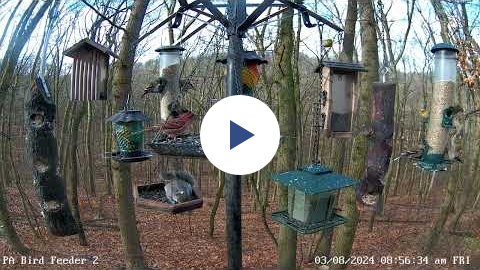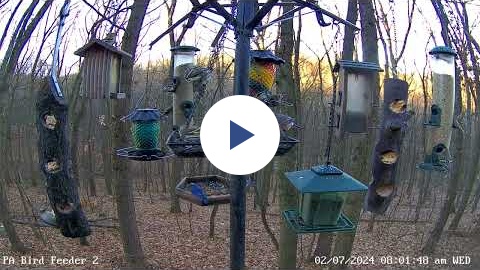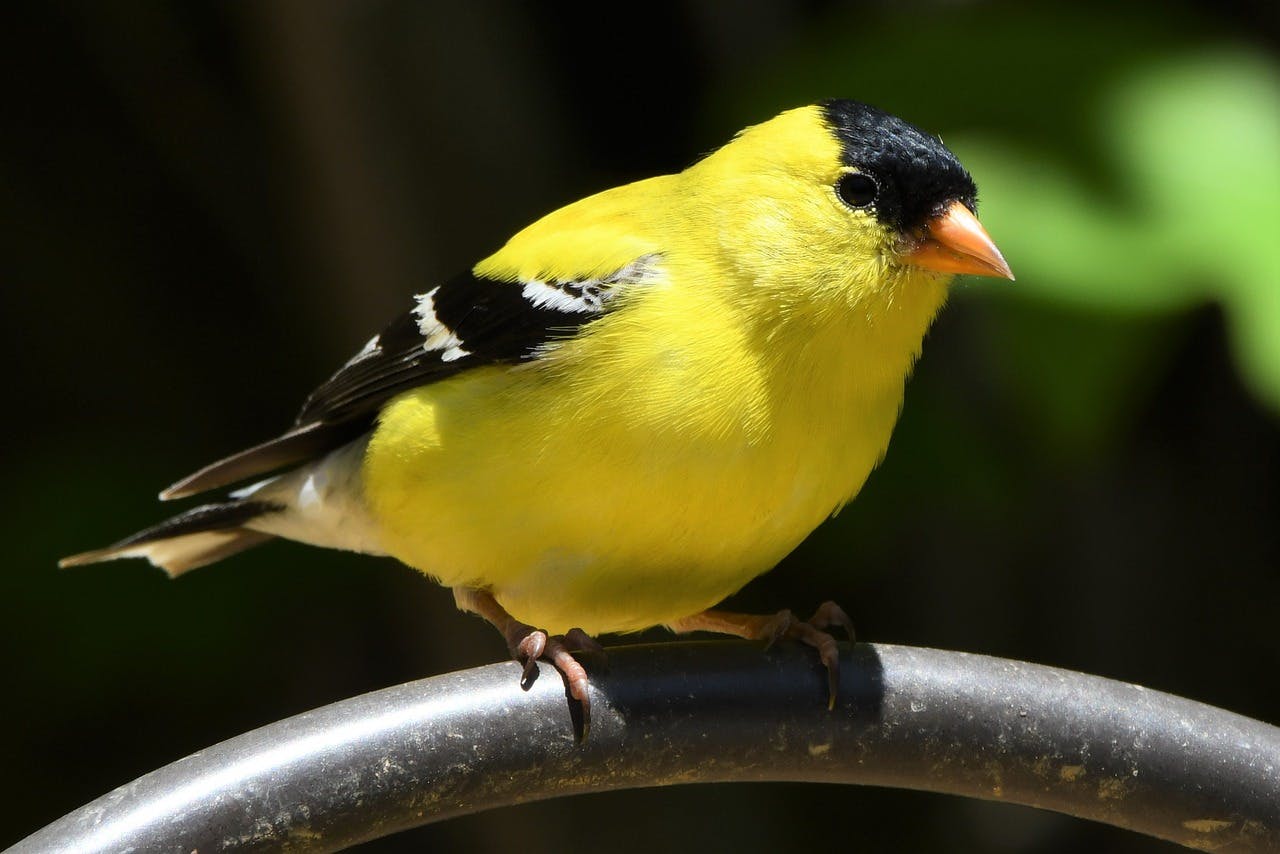All About Finches
If you enjoy watching our live streaming bird feeder camera systems you may have noticed a variety of small colorful birds feeding in great numbers on the feeders. Many of these birds you are seeing belong to the finch family. These are four finches you might see at our feeders.
Pennsylvania is home to a diverse avian population, and among its feathered residents, several species of finches contribute to the state’s rich birdlife. One notable finch species found in Pennsylvania is the American Goldfinch, recognized for its vibrant yellow plumage during the breeding season.
These small, social birds are often observed in flocks, feeding on seeds from various plants such as thistles and sunflowers.
Additionally, the House Finch is another common sight, displaying a mix of red and brown hues in males.
Females are sparrow-like, and males are similar to male purple finches, except that house finches show more streaking on the breast and flanks, are not quite as robust, and are a more bright or “strawberry” red.
Do not look for a purple bird when trying to pick out this finch species at our feeders. The male purple finch is maroon-red, sometimes described as raspberry-colored, while the female is brown with darker streaks.
The purple finch is often confused with the house finch. If you see one at your feeder you have attracted a special species many people do not often see! In Pennsylvania, purple finches nest mainly in the northern tier and at higher elevations in southern regions of the state. In winter, individuals from farther north overspread the state.
This next species of finches is another finch you do not often see at your bird feeder. With their brown colors and streaked breasts, pine siskins look like sparrows; patches of yellow in the wings and tails are good field identifiers.
In Pennsylvania, the pine siskin is a rare breeding bird in most years. It nests mainly in the northern tier in stands of hemlocks, pines, spruces and larches, and in ornamental conifers in backyards. These tame birds become much more visible when they flock to feeding stations in winter. As well as eating seeds, siskins consume the seeds of trees (alder, birch, spruce and others), weeds and grasses.
How to Attract Finches
Attracting finches to your bird feeder can be a rewarding experience, and there are several effective ways to entice these colorful birds to your backyard. Finches are particularly fond of seeds, and providing a variety of them is key. Niger and thistle seeds are a favorite among species like American Goldfinches. Investing in a specialized finch feeder with small perches and tiny feeding ports will accommodate their smaller size and encourage their visits. Offering sunflower seeds, both with shelled and sunflower hearts, can also attract a variety of finches, including House Finches, Purple Finches and Pine Siskins. Maintaining a clean feeding area and regularly replenishing the seeds will ensure a fresh and appealing environment for the birds. Additionally, incorporating native plants and shrubs in your garden can provide natural food sources and shelter, making your backyard even more enticing for finches. Patience is crucial, as it may take some time for these delightful birds to discover and frequent your feeder regularly.

Example of Goldfinches feeding on PA Bird Feeder 2
Use Sunflower Chips!
Through our experience in streaming successful bird feeding stations we have found that goldfinches prefer sunflower hearts or sunflower chips to all other seed. In fact, you can see flocks of goldfinches coming to our feeding station year round to feed on this seed along.
The best type of bird feeder for finches is a tube feeder with small perches and tiny feeding ports. These feeders are designed specifically to accommodate the small size of finches and their preference for eating tiny seeds like thistle, nyjer and sunflower hearts. The tube design helps protect the seeds from moisture and keeps them fresh longer, while the small perches discourage larger birds from monopolizing the feeder. Additionally, finches prefer feeders placed in quiet, sheltered areas, away from potential predators, ensuring they feel safe and comfortable while feeding.
Keep your Feeders Clean!
Keeping bird feeders clean is crucial for finches for several reasons. Firstly, cleanliness prevents the growth of mold, bacteria, and other pathogens on the feeder and the seeds, which can make finches sick if ingested. Secondly, dirty feeders can attract pests like rodents and insects, which may not only consume the seeds but also spread diseases to the finches. Additionally, a clean feeder ensures that the seeds remain fresh and palatable, encouraging finches to continue visiting the feeder regularly. Regular cleaning also prevents seed clogs and ensures that the feeding ports remain clear, allowing finches easy access to the food. Overall, maintaining clean bird feeders promotes the health and well-being of finches and helps sustain their populations in the area.
If you notice house finches at your bird feeder with crusty, watery, or infected-looking eyes, you are not alone. A new condition called house finch conjunctivitis, first discovered during the winter of 1993-94, is spreading through the eastern United States. Symptoms of the disease, which mainly affects house finches, include scabby, swollen, runny, cloudy-looking, or glassy eyes, mucous oozing from the nostrils, and an upper respiratory infection.
Example of House Finch Conjunctivitis |
Researchers do not know how house finch conjunctivitis is spread from one individual to another, which makes it difficult to provide specific recommendations for reducing the risk of disease.
- Clean feeders and bird baths on a regular basis with a 10 percent bleach solution.
- Avoid using moldy seed, and keep the ground area around the feeder as clean as possible. During the summer, rake the area to remove accumulated seeds beneath the feeder. During the winter, shovel fresh snow over the area.
- Use nonporous plastic, metal, or glass feeders that are easy to clean, and provide ample feeder space to reduce crowding.
- Keep platform feeders clean and put out only the amount of seed that birds can consume within a day or two.
Ways to Watch Finches at PixCams
We are currently live streaming 5 different bird feeding stations located in southwestern Pennsylvania. Each is set up in a unique setting from wooded to open setting for attracting a variety of songbirds. All feeders will have visits from various species of finches for you to see live. Links to our live feeding stations include:
• PA Bird Feeder 1
• PA Bird Feeder 2
• PA Bird Feeder 3 – Close-Up View
• LujiiGarden Bird Feeder
• St Vincent College Bird Feeder
Below are some example finch videos captured from the PixCams bird feeding stations.

Purple Finch feeding in tray on PA Bird Feeder 2

Small flock of Pine Siskins feeding on PA Bird Feeder 2

Goldfinches feeding on LujiiGarden Bird Feeder

House Finch on PA Bird Feeder 3 Close-Up View
Enjoy! Let us know of you have any questions regarding bird feeding or feeder tips please comment below.




My brother suggested I might like this blog He was totally right This post actually made my day You can not imagine simply how much time I had spent for this info Thanks